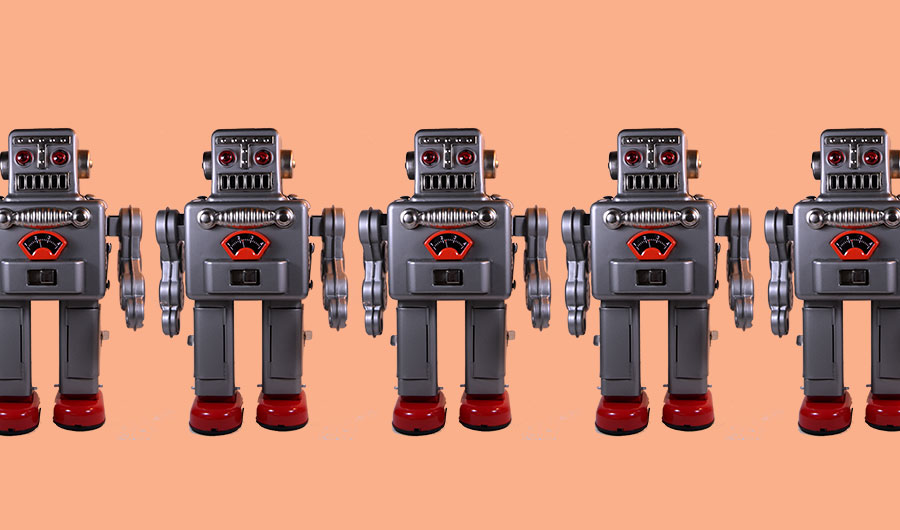Teams Of Robots Coordinate Tight, Crash-less Maneuvers

Image credits: Composite image -- Yuen Yiu, Staff Writer; Robot image -- D J Shin via Wikimedia Commons
Rights information: CC BY-SA 3.0
(Inside Science) -- Engineers have developed a minimally intrusive safety system that allows teams of robots to coordinate tight maneuvers without turning into worrywarts immobilized by fears of a fender bender. The new approach was motivated by robot "traffic jams" that developed when researchers asked tens and even hundreds of robots to work together in the same small space.
Traditional robot control systems consist of a primary controller, which tells the robot what task to accomplish, and a safety controller, which takes over if it senses a collision is imminent. But, researchers found, a too-cautious safety system can essentially paralyze a group that's trying to work together.
"We go to a hundred robots and it starts getting annoying very quickly," said Magnus Egerstedt, a roboticist at the Georgia Institute of Technology in Atlanta who studies robot swarms. "The safety mechanisms just start taking over because there is a potential for collision all the time. So the robots just stop doing stuff."
If you have only one self-driving car on a sparsely populated street, or one robotic vacuum cleaner hoovering in the living room, it's okay for the safety controller to be extra careful, Egerstedt said. But if we start packing in more and more robots, "we're going to have to be smarter in how we do it," he said.
Egerstedt and his team set out to make a safety controller that would only take over when it absolutely had to. The concept they developed relies on the fact that the teams of robots can communicate with each other and have agreed to the same basic set of rules.
"Each robot has a notion of what is expected behavior of the other robots," Egerstedt said. "The benefit really comes when they're amongst their own kind."
It's similar in some ways to how humans walk through crowds. Because of a social contract governing accepted behavior in congested areas, people will tolerate very close spacing without fear of collisions.
One way the team tested their new safety system was to tell small, wheeled robots stationed in a square pattern to switch places with the robots opposite them.
In a sense, they're actually being asked to slam into each other, Egerstedt said. But the safety controller takes over just before a collision, and the robots end up tightly circling each other before heading in opposite directions.
A minimally invasive safety system helps robot teams accomplish their tasks while avoiding collisions.
Although the action looks almost choreographed, the researchers didn't know ahead of time how the robots would move.
"I was so delighted that things like traffic rules almost seemed to emerge," Egerstedt said. "We didn't tell them to spiral clockwise or counterclockwise, but it just turned out that's how they resolved the issues."
The system is no riskier than standard safety controllers, Egerstedt said. It shrinks the safety bubble when robots are interacting with predictable objects like other team members or stationary obstacles, but becomes like the old safety system if faced with an outsider who's not playing along. At the end of the above video, when a big bully robot continues to plow forward, the small robots give it a wide berth.
The team presented the outsider robot interactions in July at the American Control Conference in Boston. They will also present a paper about the project at the upcoming Institute of Electrical and Electronics Engineers Conference on Decision and Control in Las Vegas this December.
George Pappas, a researcher at the University of Pennsylvania in Philadelphia who specializes in control systems, said the IEEE conference paper presents a very creative solution for robots to meet multiple safety objectives, such as staying connected, avoiding obstacles and avoiding each other. Pappas co-authored a 2011 paper on robot connectivity with Egerstedt, but was not involved in the current research.
"This work is a good tool in the tool box," said Carlo Pinciroli, a roboticist at Worcester Polytechnic Institute in Massachusetts who specializes in swarm algorithms. He said he'd like to see more experimental demonstrations of the control system with much larger robot groups, and in failure scenarios where one or more robots might break down.
Densely packed, coordinated robot teams could one day clean office buildings at night, transport objects across warehouse floors, or fly over disaster zones searching for survivors.
The Georgia Tech team has recently taken their own testing to the air. They have begun using the new control system on quadcopters, tiny helicopters a few inches across with four rotors.
"One of my favorites is we have a bunch of quadcopters spiraling around, and then we have this poor quadcopter that's supposed to go through this swarm unscathed. It looks just awesome," Egerstedt said.
The Georgia Tech team tests a collision avoidance system with spiraling quadcopters.

